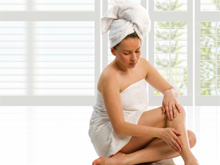Health Topics
-
Healthy Living
-
|
|
April 2011
|
| Taking Care of Dry Skin |
| Dr. Maya Vedamurthy & Dr. Priya Jnanesh Talageri |
| |
 |
Dry skin is a very common skin problem and often worsens during times like this when the environmental humidity is low. It can occur in all ages and in people with or without other skin problems. |
Why is Dry Skin Bad?
- Doctors classify some types of skin as xerosis or asteatosis (the medical words for dry skin, of course), when the normally fine lines in the skin become more visible, and the skin feels rough and appears dull and flaky.
- Dry skin very commonly produces itching, which can be severe and can interfere with sleep and other daily activities.
- Dry,thickened skin can crack, especially in areas subject to chronic trauma (like hands and feet),causing painful cracks in the skin (fissures).
- Severe dry skin is a feature of certain genetic diseases such as atopic dermatitis and ichthyosis (fish-scale like skin).
- On some occasions even doctors might confuse red, dry skin rashes with other skin problems.
What Causes Dry Skin?
The outermost layer of the skin - stratum corneum - consists of dead skin cells embedded in a mixture of natural oils (lipids). They hold a certain amount of water, which helps keep the skin soft, pliable and smooth.
Dry skin results when there is not enough water in the stratum corneum. Too much soapy water, exposure to harsh chemicals, the normal ageing process and certain types of skin diseases are some of the causes of decreased amounts of protective skin oils.
9 Bath Tips
The mainstay of dry skin management is attention to proper bathing techniques and liberal use of effective moisturisers.
- You should take a short bath or shower (no more than three minutes) only once in a 24 hour period. Yes, you read that right – three minutes a day.
- The bath or shower should be in lukewarm, rather than, hot water.
- Soap should be used minimally and only when and where needed. Don’t go by the commercials on TV, where the model is just lathering up all over.
- Milder and less drying soaps include Dove and Neutrogena Dry Skin Formula(unscented).
- Cetaphil is a liquid cleanser that works as a gentle and effective soap substitute for some people. It is especially helpful for cleaning the face and hands.
- After bathing or showering, quickly and gently pat the skin partially dry with a towel (do not rub!).
- Within three minutes of getting out of the water, apply a moisturiser to seal the water in the skin before it can evaporate.
- Bath oil should not be added to bath water since this can make the floor dangerously slippery.
- Moisturisers should be reapplied liberally when possible.
Special Attention
- Treat any red dermatitis (eczematous) patches with a topical cortisone (steroid) cream or ointment for a 5 to 15 day course.
- Make sure you understand where the cortisone cream or ointment is to be applied (only on the red patches unless instructed otherwise), and how often you should apply it (no more than twice daily).
- When using both, a cortisone product and a moisturiser, always use the cortisone first and the moisturiser second.
- Be careful about using other over-the-counter anti-inflammatory and itch-suppressing creams or lotions. Anti-itch products containing pramoxine or menthol and camphor are generally safe to use. However, these products do not treat the cause of skin dryness.
|
 |
Dr. Maya Vedamurthy is Consultant dermatologist at Apollo Hospitals, Chennai
Dr. Priya Jnanesh Talageri is Associate consultant dermatologist at Apollo Hospitals, Chennai |
|
|